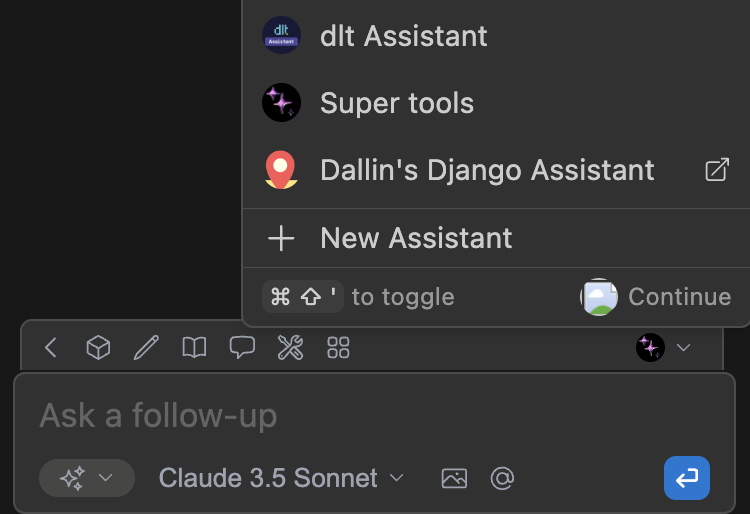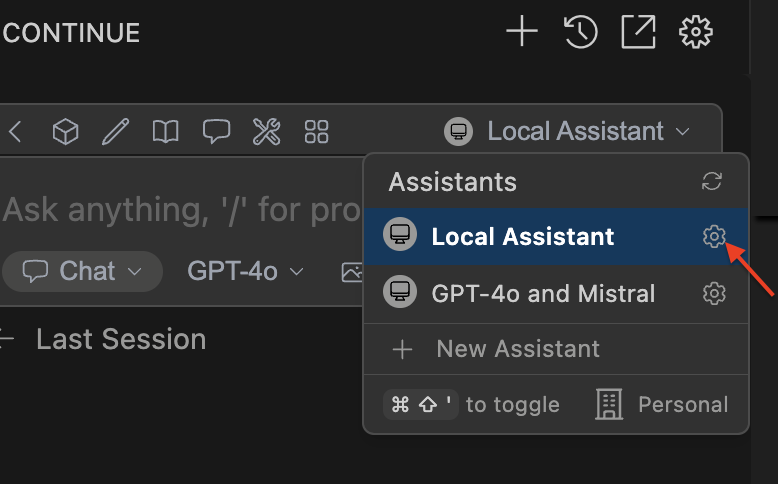Configuration
You can easily access your assistant configuration from the Continue Chat sidebar. Open the sidebar by pressing cmd/ctrl + L (VS Code) or cmd/ctrl + J (JetBrains) and click the Assistant selector above the main chat input. Then, you can hover over an assistant and click the new window (hub assistants) or gear (local assistants) icon.

Hub Assistants
Hub Assistants can be managed in the Hub. See Editing an Assistant
YAML Config
Local user-level configuration is stored and can be edited in your home directory in config.yaml:
~/.continue/config.yaml(MacOS / Linux)%USERPROFILE%\.continue\config.yaml(Windows)
To open this config.yaml, you need to open the assistants dropdown in the top-right portion of the chat input. On that dropdown beside the "Local Assistant" option, select the cog icon. It will open the local config.yaml.

When editing this file, you can see the available options suggested as you type, or check the reference below. When you save a config file from the IDE, Continue will automatically refresh to take into account your changes. A config file is automatically created the first time you use Continue, and always automatically generated with default values if it doesn't exist.
See the full reference for config.yaml here.
Deprecated configuration methods
View the config.json migration guide here
config.json- The original configuration format which is stored in a file at the same location asconfig.yaml.continuerc.json- Workspace-level configurationconfig.ts- Advanced configuration (probably unnecessary) - a TypeScript file in your home directory that can be used to programmatically modify (merged) theconfig.jsonschema:~/.continue/config.ts(MacOS / Linux)%USERPROFILE%\.continue\config.ts(Windows)
.continuerc.json
The format of .continuerc.json is the same as config.json, plus one additional property mergeBehavior, which can be set to either "merge" or "overwrite". If set to "merge" (the default), .continuerc.json will be applied on top of config.json (arrays and objects are merged). If set to "overwrite", then every top-level property of .continuerc.json will overwrite that property from config.json.
Example
{
"tabAutocompleteOptions": {
"disable": true
},
"mergeBehavior": "overwrite"
}
config.ts
config.yaml or config.json can handle the vast majority of necessary configuration, so we recommend using it whenever possible. However, if you need to programmatically extend Continue configuration, you can use a config.ts file, placed at ~/.continue/config.ts (MacOS / Linux) or %USERPROFILE%\.continue\config.ts (Windows).
config.ts must export a modifyConfig function, like:
export function modifyConfig(config: Config): Config {
config.slashCommands?.push({
name: "commit",
description: "Write a commit message",
run: async function* (sdk) {
// The getDiff function takes a boolean parameter that indicates whether
// to include unstaged changes in the diff or not.
const diff = await sdk.ide.getDiff(false); // Pass false to exclude unstaged changes
for await (const message of sdk.llm.streamComplete(
`${diff}\n\nWrite a commit message for the above changes. Use no more than 20 tokens to give a brief description in the imperative mood (e.g. 'Add feature' not 'Added feature'):`,
new AbortController().signal,
{
maxTokens: 20,
},
)) {
yield message;
}
},
});
return config;
}